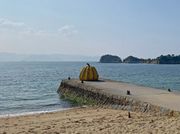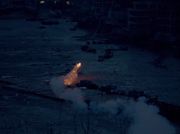Chinese contemporary artist Cai Guo-Qiang's pyrotechnic works have been realised on paper, outdoors, and as a VR. In his often large-scale creations, Cai traces histories of human violence while investigating the potential of healing by explosion.
Read MoreThe artist was the Director of Visual and Special Effects for the 2008 Beijing Olympic Games, opening the event with one of his massive firework displays.
Born in Quanzhou, Fujian province, Cai was nine years old when the Cultural Revolution began. His father, who was a book collector and calligrapher, burned his collection of books to avoid persecution—an event that greatly affected him and young Cai.
Traditional Chinese beliefs he was brought up with, as well as Qi Gong and the philosophies of Feng Shui and Buddhism, remain influential to the artist.
In his often large-scale creations, Cai traces histories of human violence while investigating the potential of healing by explosion.
Cai first began to work with gunpowder in 1984, while he was a student at the Shanghai Drama Institute. In his 2014 conversation with Ocula Magazine, the artist recalled that his experiments began as a desire to be 'more open and bold' as an artist. Moving from painting with brushes to burning canvases and throwing mini rockets at them, Cai finally settled on using gunpowder as a medium.
The year after he graduated in 1985, Cai moved to Japan with hopes for greater artistic freedom. Although Japan certainly had greater freedoms, he discovered that gunpowder was more difficult to buy, whereas it had been easier to access in China. Cai nevertheless lived in Japan for nine years, holding his first solo exhibition in Tokyo in 1987.
Human Abode, Project for Extraterrestrials No.1, Cai's first explosive work, took place at the Tama River Fussa Outdoor Art Exhibition in 1989. Using twigs and fabric, the artist devised a simple yurt that he then detonated with gunpowder.
With his gunpowder works also came gunpowder drawings, for which Cai carried out controlled explosions on paper. They often reference traditional Chinese imagery and calligraphy, such as the vast expanses of landscape in the 42-panel Odyssey (2010).
In Japan, Cai also became interested in the lasting effects of atomic bombings on both nature and human life. The Earth Has Its Black Hole Too (1994) saw the artist dig into the ground at the centre of Hiroshima Park, and arrange 114 helium balloons, 2,000 metres of fuse, and three kilograms of gunpowder in an ascending spiral. Once lit, the ignition moved down towards the deep, 'black hole' at the centre of the park, an ominous warning that equates nuclear power with a black hole. In 2007, the work was awarded the 7th Hiroshima Art Prize.
Cai moved to New York in 1995, where he has since lived and worked. He continued to explore the resounding implications of nuclear energy, setting off explosions in nuclear test sites and Land Art locations across the United States in 'The Century with Mushroom Clouds: Projects for the 20th Century' series (1996). The mushroom clouds Cai created—captured in photographs and short videos—were non-radioactive, reflecting his beliefs that they may serve to purify what has already been and what may come.
Cai has long been fascinated by the universe and extraterrestrial life. In his 1993 Project to Extend the Great Wall of China by 10,000 Meters, the artist blew up 10 kilometres of explosives near the Great Wall as a signal to outer space.
Another of Cai's ambitious projects had been to send a ladder of light into the sky. After three failed attempts in Bath, England (1994), Shanghai (2001), and Los Angeles (2012), he finally succeeded in launching Sky Ladder over the Huiyu Island Harbour in 2015. A huge white balloon, carrying a 500-metre ladder covered in fuses and gold fireworks, was released into the sky against the morning sun as a gesture of hope and a gift to the artist's 100-year-old grandmother.
Sky Ladder is also the title of Cai's biographical documentary, directed by Kevin Macdonald, that premiered at the Sundance Film Festival in 2016.
Animals in Cai Guo-Qiang's sculptural installations are typically an allegory of humanity. Participating in the inaugural Hugo Boss Prize exhibition in 1996, Cai presented Cry Dragon/Cry Wolf: The Ark of Genghis Khan, a massive dragon constructed from sheepskins and Toyota car engines that references the emergence of Asia as a major player in international politics and the global economy.
Reflection (2004) similarly revolves around waves of change. Consisting of an excavated boat from Iwaki, Japan and porcelain Kuan Yin figures, the installation alludes to the rapid transformation of Japan from its traditional past to the 'modern' present. During this globalisation process, wooden boats were quickly replaced by their resin counterparts.
Cai Guo-Qiang ventured into VR with Sleepwalking in the Forbidden City (2020), made in collaboration with HTC VIVE Arts, in which fireworks explode over a model of the majestic palace complex. The artist filmed parts of the fireworks scene in real life, closely replicating the physical sensation of experiencing fireworks.
Cai has curated numerous exhibitions, among them Non-brand 非品牌, as part of Artistic License: Six Takes on the Guggenheim Collection, Solomon R. Guggenheim Museum, New York (2019); What About the Art?: Contemporary Art from China, Al Riwaq, Qatar Museums, Doha (2016); Kiki Smith: Color Still, Under Museum of Contemporary Art, Tuscany (2010); and Virgin Garden: Emersion, the inaugural China Pavilion, 51st Venice Biennale (2005).
Cai Guo-Qiang has exhibited internationally in important solo and group exhibitions.
Select solo exhibitions include Odyssey and Homecoming, Palace Museum, Beijing (2020); Gunpowder Art, Ashmolean Museum, Oxford (2019); The Spirit of Painting. Cai Guo-Qiang at the Prado, Museo Nacional del Prado, Madrid (2017); The Ninth Wave, Power Station of Art, Shanghai (2014); Falling Back to Earth, Queensland Art Gallery | Gallery of Modern Art (QAGOMA), Brisbane (2013); Cai Guo-Qiang: Saraab, Arab Museum of Modern Art, Doha (2011); and I Want to Believe, Solomon R. Guggenheim Museum, New York (2008).
Select group exhibitions include 30th Anniversary Exhibition: The Seven Lamps of the Art Museum, Hiroshima City Museum of Contemporary Art (2019); The Allure of Matter: Material Art from China, Los Angeles County Museum of Art (LACMA) (2019); Scenes for a New Heritage: Contemporary Art from the Collection, Museum of Modern Art (MoMA), New York (2015); Ink Art: Past as Present in Contemporary China, MoMA, New York (2013); Meeting Point, 10th Havana Biennial (2009); and Prospect. 1, New Orleans (2008).
Recognised for his contributions to contemporary art, Cai has received international art awards including the Golden Lion Prize at the 48th Venice Biennale (1999); the Hiroshima Art Prize (2007); the 24th Praemium Imperiale — Lifetime Achievement in the Arts (Painting) (2012); and the Isamu Noguchi Award (2020).
Cai Guo-Qiang's website can be found here and his Instagram account can be found here.
Sherry Paik | Ocula | 2021





